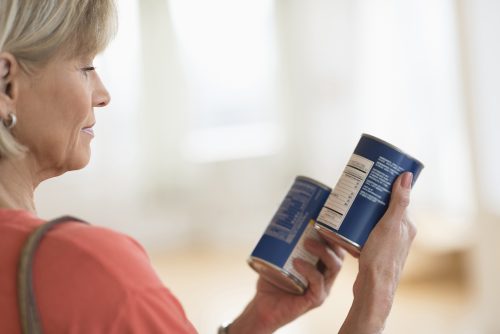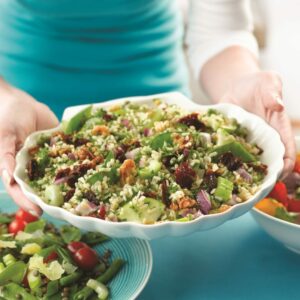
In addition to the health claims, there's the Heart Foundation tick, fair trade labels, organic labels – what do they all mean?
Good source of energy
This means it's high in kilojoules (calories), not that it has special properties that will invigorate you.
85% less saturated fat
This probably means the manufacturer has reformulated the product to use monounsaturated or polyunsaturated fats instead of saturated fats. That's good. But don't think it means low-fat.
Reduced-fat
Means this product has less fat than the regular variety. It does not mean low-fat. For example, standard cheddar cheese has 35% fat and reduced-fat cheddar 24%. Not low-fat; lower-fat. The label must also show a comparison with the regular product.
Light/lite
This could mean one of many things, so don't be fooled! It might mean the product has less energy (kJ) or fat than the original formula. But it could also mean it's light in colour or flavour, as in 'light' olive oil, or it could even mean that it's a light (thin) cut, as in potato chips. Read the nutrition panel to see what's really going on.
Cooked in vegetable oil
Palm oil, which is nearly 50% saturated fat – the stuff that will harden your arteries – qualifies as a vegetable oil and is widely used in the food industry. If the vegetable oil is not named, assume it's not good. Usually the manufacturer will let you know if they are using the better canola, sunflower or soy bean oils.
Cholesterol-free
Cholesterol-free does not imply low-fat. Some products that highlight 'cholesterol-free' are very high in fat and if you're interested in lowering your blood cholesterol levels or keeping them down, you need to be watching the amount of saturated fats you consume.
Cholesterol only comes from animal fats. Some products have 'cholesterol-free' highlighted when they don't contain animal fats – so they never had cholesterol in them. For example, most crackers don't contain animal fats, but some still make the 'cholesterol-free' claim. Often it tells you nothing in comparison to other similar products. Don't be fooled.
Gluten-free
This means there is no detectable gluten in this food. It will not contain oats or other gluten-containing foods, nor cereals containing gluten that have been malted. This is very helpful for people with coeliac disease. If the pack doesn't state gluten-free it can be difficult to know, even if you do look at the ingredients.
Low-salt or low-sodium
Contains less than 120mg per 100g.
Diet
A food or drink labelled as 'diet' will have less energy (kJ) than the regular product and will usually contain artificial sweeteners rather than sugars.
96% fat-free
Means 4% fat. Good to know quickly without having to look at the nutrition information, but remember it doesn't mean that other similar products won't be lower.
And of course, if it says '93% fat-free' you know it has 7% fat, which may be too high for what you want.
Whole grain
For a product to be labelled whole grain it must retain the endosperm, germ and bran of the grain.
This can mean the whole intact grain, as you might expect, but that's not always the case.
It can also mean the grains have been ground, milled, cracked or flaked, but the three parts of the grain – the endosperm, germ and bran – are all present in the same proportions that are typical of the whole cereal.
This is why you may see some highly processed cereals that are still able to call themselves whole grain. Even though they are highly processed, they still contain all of the fibre and nutrients of the whole grain.
Baked not fried
Fried food is not recommended as it tends to be very high in fat and often high in saturated fat. But manufactured baked foods be can just as high, so be wary when you see this label.
Some snack foods are low in fat: pretzels are usually low in fat, some less than 3%, and many rice crackers are less than 4% fat.
But some crackers with the 'baked not fried' label are more than 25% fat. 'Baked not fried' by itself is meaningless; you need to read the nutrition panel to know what you're getting.
Check the total and saturated fat content per 100g, and compare to other products.
No added sugar
Means just that – they didn't add any. But it does not mean that it contains no sugar.
The product could still contain lots of natural sugar, like in dried fruit, honey or fruit juices, so check the nutrition information panel.
Note: A flat teaspoon of sugar weighs 4g. If you can remember your 4 x table, this can come in handy next time you're looking at a label. Figuring out if 20g of sugar is a lot is tricky; visualising it as 5 teaspoons of sugar makes much more sense.
Flavoured
A 'raspberry-flavoured' food won't contain any raspberries, it will just have raspberry flavouring.
That's fine, but even though it will be stated on the front panel with the name of the food, often the word 'flavoured' is in much smaller type.
The Tick
The Tick is a programme run by the National Heart Foundation of NZ.
Manufacturers who want to feature the Tick on their products must formulate (or re-formulate) products to fit the Tick criteria for that particular product category.
Tick products often have lower levels of energy, fat, saturated and trans fat, sugar and salt than other products in the same category, and they're often higher in calcium and fibre.
So it can be a useful way to quickly choose products with a healthier profile.
If your favourite product doesn't have a Tick, compare the nutrition label to one that does; because there's a cost to manufacturers for the Tick programme, not all choose to take part.
Just because something doesn't have a Tick doesn't necessarily mean it's not a good option.
It's also important to remember that a Tick doesn't mean you can eat unlimited amounts.
Some categories that include Tick products will always be 'sometimes' foods.
Fair trade
In New Zealand, fair trade products are identified by the Fairtrade label. Items that carry this label must meet independently monitored international fair trade standards.
The Fairtrade guarantee to consumers is backed by a certification and trade audit system that applies to every link in the supply chain. This chain includes producers, importers and licensees, who are licensed to apply the Fairtrade label to packaged products and sell them into the market. Currently 27 New Zealand companies are licensed to carry the Fairtrade brand.
Organic badges
Biogro: This label means BIO-GRO has certified this product as fully organic. BIO-GRO New Zealand is a non-profit organisation formed in 1983. It certifies over 900 producers in NZ.
The BIO-GRO NZ Organic Standards are internationally recognised by the International Federation of Organic Agriculture Movements (IFOAM,) which means products carrying this mark adhere to international standards for organic products.
Biogro producers and growers must comply with a strict set of standards which are then independently audited.
AgriQuality: This label means the product has been certified as fully organic by AgriQuality. A state-owned enterprise which offers organic certification, AgriQuality's Organic Standard is also IFOAM accredited.
Every AgriQuality producer who is certified has a unique customer number, which can also be found on the label.
Demeter: This label means the producer adheres to biodynamic farming practices.
This is a method of organic farming which takes into account the influences of the sun, moon, planets and stars.
Demeter is a worldwide certification system, used to verify to consumers in over 50 countries that food has been produced by biodynamic methods.
What about imported products?
It can be hard to tell what organic labels mean on imported products.
Look for the IFOAM logo, which most producers will include as well as their local certification mark.
www.healthyfood.com










